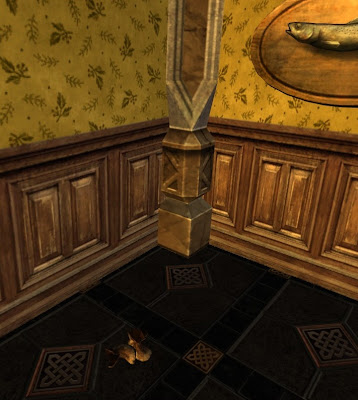 |
| Stoor Boots in a Dwarf Home |
Precisely. Because the Hobbits we encounter in Enedwaith are Stoors, and that means many of our typical Hobbit stereotypes go out the window.
I already discussed a bit about the three varieties of Hobbits in A Hobbit Boating Adventure, particularly what qualities are exemplified by the Fallohides. The Stoors are a bit different.
The wearing of boots is a quality shared by many of the Hobbits in the Eastfarthing, back in The Shire, particularly around the area of the Marish (where Farmer Maggot lives). The prologue Concerning Hobbits tells us these Hobbits wore boots in muddy weather, and that many had "down" growing on their chins, unlike any Fallohide or Harfoot. Many of the residents of this area indeed have Stoor blood, and their ancestors came into The Shire and Buckland later than other Hobbits, arriving "from south-away," bringing some strange customs, names, and words. The building of farmhouses and barns was said to originate with these Hobbits as well. Physically, Stoors are described as being "broader, heavier in build; their feet and hands were larger, and they preferred flat lands and riversides."
Hobbit legends tell of the time preceding their Wandering Days, long before they came west to Bree-land and The Shire, when they dwelt along the upper Anduin "between the eaves of Greenwood the Great and the Misty Mountains." After many other Hobbits chose to cross the Misty Mountains, when Men began to increase in numbers and a darkness descended on Mirkwood, the Stoors lingered behind along the banks of the Anduin. When they finally began to move west, they followed the course of the River Loudwater (the Bruinen), with some settling in the Angle - the triangle in the southwestern Trollshaws formed by the meeting of the Bruinen and the River Hoarwell. Still others continued south, settling between the deserted city of Tharbad and the borders of Dunland.
 |
| Boots and a beard - gotta be a Stoor. |
Linguistically, Hobbits seem to have adopted the languages of Men near where they happened to be settled at a given point. This was seen in the Hobbits who moved into Bree-land adopting the Common Speech. Before coming west, however, it appears that the Hobbits who lived along the Anduin spoke another variation of a Mannish language that was said to be akin to the language of the Rohirrim. The southernmost Stoors were said to have adopted a language related to Dunlendish. Interestingly, the Stoors who lived in the Angle in the Trollshaws before returning to Wilderland "had already adopted the Common Speech, but Déagol and Sméagol are names in the Mannish language of the region near the Gladden." Even the word "Hobbit" is believed to be derived from a word of the Rohirrim, "holbytla," meaning hole-dweller.
Talk about two infamous Stoors. But all peoples have some they'd like to disown, right?
At any rate, after hearing a lot of surprise from individuals when Enedwaith first came out and they would stumble upon these curious bearded and booted Hobbits who would make them do strange things like pick up pig poo, it became apparent that possibly many players were not aware of the rich history that this little remnant of Hobbits who had stayed behind in Enedwaith were based on. Next time you are in Enedwaith, stop by and give 'em a hand with their fertilizer endeavours. They'll give you a special reward if you help often enough!
Sources: Concerning Hobbits, The Fellowship of the Ring; Appendix B & Appendix F, The Lord of the Rings
I was very pleased to find the Stoors. And I love the guy sitting outside the village who says he told one of the others to "put it in his pipe and smoke it" hehe.
ReplyDelete